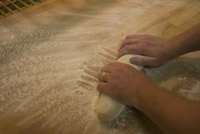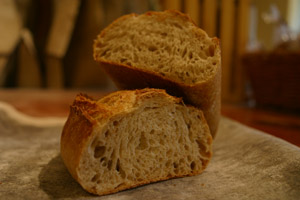What are Artisan
Breads?
Bread in its original
form of a blend of flour, water and
salt has been around for thousands
of years and continues to be an
important part of a well-balanced
diet.
 |
During the Industrial Revolution,
the bread-making process was
mechanized. Batches of dough
were mixed in machines (much like
giant concrete mixers), mechanically
kneaded, weighed and chopped into
loaf-sized blobs that were
automatically dropped into
standard-sized pans to rise and then
be baked. The advent of this white
“wonder bread” reflects the low
point in the history of bread
making, as well as in the
nutritional value of this daily
staple. |
Over the past 15
years in the United States and more
recently in Canada, discerning consumers with
high expectations for healthy food
and demand for quality products have
increased the demand for Artisan
Breads, like those that have been
available in Europe for hundreds of
years.
Artisan Breads are made with pure,
natural ingredients with
no additives or dough enhancers.
Generally made in small batches and
using a slow process, a natural
fermentation process is encouraged,
thus enhancing the flavour, colour,
aroma, texture and final shape of
each loaf. Artisan breads use little
or no yeast and when yeast is used,
fresh is preferred over the dry
yeast used by most commercial
bakeries. These natural breads are
baked in stone-hearth ovens
replicating the wood burning brick
ovens of yesteryear.
The tangy taste of
naturally leavened breads is the
result of the natural fermentation
process. Like salt and pepper, it
enhances the flavour of the foods it
accompanies.

What should I look for when buying artisan bread?
There are five major criteria to consider when buying a quality bread:
Colour:
This deals primarily with the
exterior colour of the loaf. The
loaf should be evenly baked and
exhibit a warm golden colour, much
like the wheat from which it is
made.
Aroma: Bread should contain the sweet,
nutty aroma of wheat. If you detect
unnatural aromas resembling ammonia
or cleaning agents, these come from
dough enhancers and additives.
Weight: The weight of the loaf should be in
proportion to its size. An oversized
loaf that weighs almost nothing is
generally filled with air and has
been made with volume increasing
dough enhancers or additives.
Crumb: The inside of the loaf
should contain numerous irregular
holes that are evenly distributed,
yet be sturdy enough to hold your
favourite toppings or spreads
without falling apart.
Flavour: You should taste the nutty flavour
of roasted wheat and grains as
opposed to the flavours of sugars,
eggs or preservatives. When you
taste quality bread, it should be
enjoyable without anything on it and
have a delicious flavour of its own.
Why Choose Naturally Leavened Bread?
Naturally leavened
breads are easier to digest due to their
slow, extended, 24 hour fermentation
with leaven. During the long
fermentation required to produce a
natural leaven or sourdough, the
natural cultures “predigest” the
grain, converting carbohydrates into
simple sugars and breaking down
proteins, making naturally leavened
bread easier to assimilate in our
digestive systems. This is similar
to how beneficial bacteria will
culture milk into yoghurt and
cheese. |